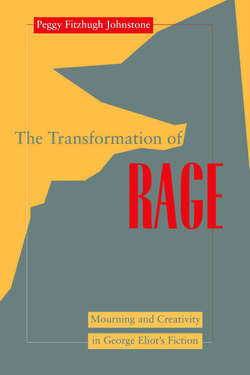Transformation of Rage

Реклама. ООО «ЛитРес», ИНН: 7719571260.
Оглавление
Peggy Fitzhugh Johnstone. Transformation of Rage
About NYU Press
Contents
Foreword
Acknowledgments
Introduction
ONE. Self-Disorder and Aggression in. Adam Bede
TWO. Narcissistic Rage in The Mill on the Floss
THREE. Loss, Anxiety, and Cure: Mourning and Creativity in. Silas Marner
FOUR. Pathological Narcissism in. Romola
FIVE. Fear of the Mob in Felix Holt
SIX. The Vast Wreck of Ambitious. Ideals in Middlemarch
SEVEN. The Pattern of the Myth of. Narcissus in Daniel Deronda
Conclusion
Works Cited
Index
Отрывок из книги
Thank you for buying this ebook, published by NYU Press.
Sign up for our e-newsletters to receive information about forthcoming books, special discounts, and more!
.....
Born Mary Anne Evans into a conventional Warwickshire (Midlands) household in 1819, her first major early childhood loss, as I will argue in my chapter on Silas Marner, seems to have been her sense of disconnection from her mother following the deaths of newborn twins when Mary Anne was a toddler; her mother, who suffered from ill health afterward, appears to have been virtually missing from Mary Anne’s life after that time. The Evans household at Griff provided her with other attachments, however, and she became very close to her older brother Isaac, her chief playmate before their school days, and to her father, who apparently treated her as his favorite of the three children of his second wife. When Isaac was eight years old, he was sent to a boarding school near Coventry, at the same time that Mary Anne, age five, was sent with her older sister Chrissey to a boarding school three miles from home. The two girls came home only occasionally, on Saturdays and holidays. The young Mary Anne’s reaction to the separation from loved ones at home is evident in the middle-aged Eliot’s lingering memory, as John Cross, her husband during the last six months of her life, records, of "the difficulty of getting near enough the fire in winter, to become thoroughly warmed, owing to the circle of girls forming round too narrow a fireplace. This suffering from cold was the beginning of a low general state of health: also at this time she began to be subject to fears at night. . . . she told me that this liability to have 'all her soul become a quivering fear,' which remained with her afterwards, had been one of the supremely important influences dominating at times her future life" (8-9). Mary Anne’s early childhood closeness to her brother was never restored. According to Eliot’s biographer, Gordon Haight, Isaac, whom she now saw only on holidays, began to grow away from her, and Mary Anne turned to books for consolation (Biography 7). Thus began what I see as a lifelong pattern of response to loss.
In 1828, Mary Anne was sent to Mrs. Wallington’s Boarding School in Nuneaton, where she studied English, drawing, French, and piano, and where she came under the influence of the principal governess, Maria Lewis, a devoted Church of England Evangelical who was to remain a close friend for many years, even after Mary Anne left the school. During her four years at Mrs. Wallington's, following Lewis’s example, Mary Anne read repeatedly the whole King James version of the Bible, at the same time that she developed the habit of introspection. In Haight’s view, these early practices contributed both to the later development of her "vigorous prose," and to her extraordinary capacity for psychological analysis (9). When she had mastered the offerings at Mrs. Wallington’s school, her parents were advised to send her to the Misses Franklins' school in Coventry, which she entered in 1832. There she studied English, French, history, arithmetic, drawing, and music. She seems to have excelled in every subject; she was remembered by a fellow student as "immeasurably superior" to the others (Laski 16-17). At the Franklins' school she also dropped her Midland dialect as she learned a more "cultivated" version of English pronunciation (Haight, Biography 11), and she was exposed to the writings of many English authors, including Shakespeare, Milton, Isaac Watts, Pope, Young, Cowper, Southey, Moore, and Byron. She also read historical novels by Bulwer Lytton, Scott (her lifelong favorite), and G. P. R. James, and wrote her own first piece of fiction, "Edward Neville," a romance that reflects the influence of her current reading; it begins "on a bright and sunny morning toward the end of the Autumn of the year 1650" when "a stranger mounted on a fine black horse descended the hill which leads into the small but picturesque town of Chepstow" (Haight, Biography 10-15; text 554-60). Mary Anne participated in the serious religious life of the school, where conversion was taught to be the beginning of the religious life. In Haight’s view, her increasing interest in the "gloomy Calvinism" that had resulted in new practices of self-denial only served to increase the distance from her brother, who had "imbibed High Church views" at his own school (19).
.....